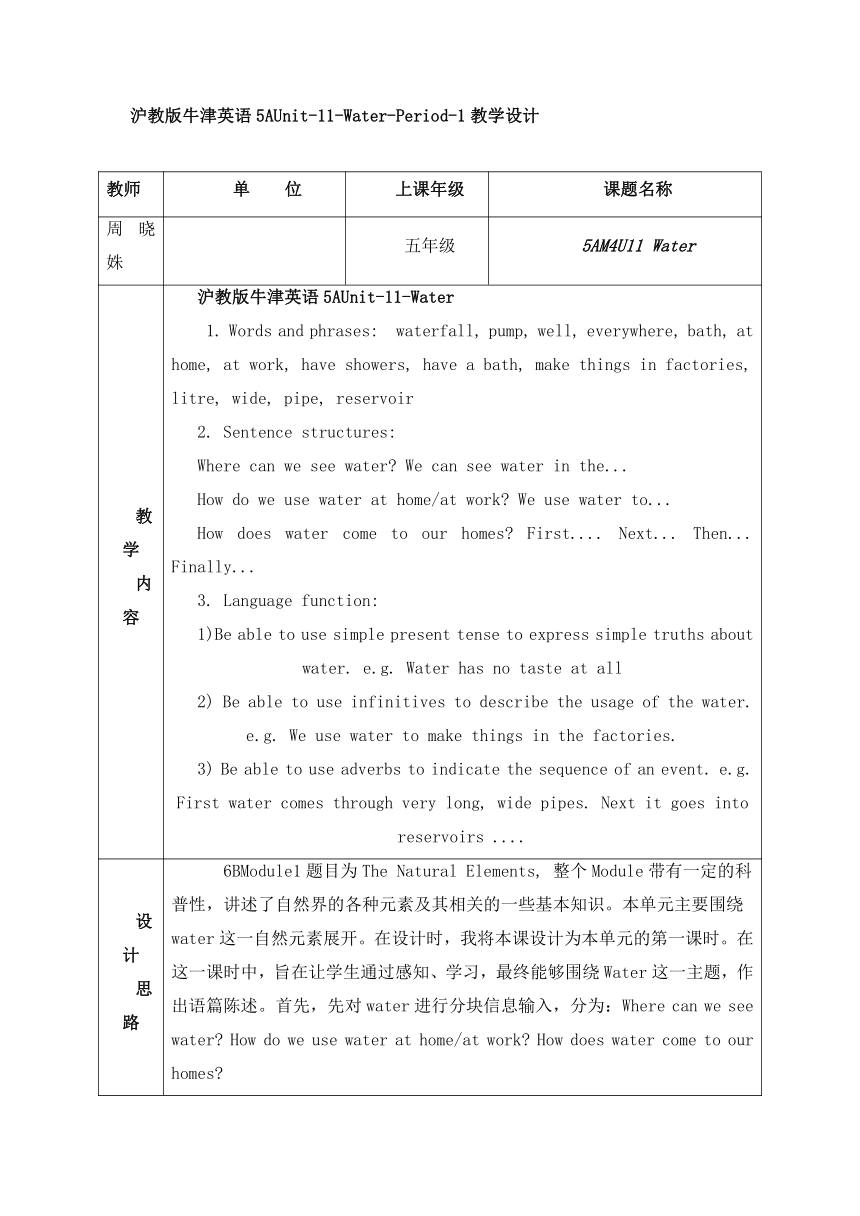牛津上海版(深圳用)五年级上册英语 Unit 11 Water(第1课时)教案(表格式)
文档属性
| 名称 | 牛津上海版(深圳用)五年级上册英语 Unit 11 Water(第1课时)教案(表格式) |  | |
| 格式 | doc | ||
| 文件大小 | 22.6KB | ||
| 资源类型 | 教案 | ||
| 版本资源 | 牛津深圳版 | ||
| 科目 | 英语 | ||
| 更新时间 | 2021-10-28 18:00:01 | ||
图片预览



文档简介
沪教版牛津英语5AUnit-11-Water-Period-1教学设计
教师 单 位 上课年级 课题名称
周晓姝 五年级 5AM4U11 Water
教学 内容 沪教版牛津英语5AUnit-11-Water 1. Words and phrases: waterfall, pump, well, everywhere, bath, at home, at work, have showers, have a bath, make things in factories, litre, wide, pipe, reservoir 2. Sentence structures: Where can we see water We can see water in the... How do we use water at home/at work We use water to... How does water come to our homes First.... Next... Then... Finally... 3. Language function: 1)Be able to use simple present tense to express simple truths about water. e.g. Water has no taste at all 2) Be able to use infinitives to describe the usage of the water. e.g. We use water to make things in the factories. 3) Be able to use adverbs to indicate the sequence of an event. e.g. First water comes through very long, wide pipes. Next it goes into reservoirs ....
设计 思路 6BModule1题目为The Natural Elements, 整个Module带有一定的科普性,讲述了自然界的各种元素及其相关的一些基本知识。本单元主要围绕water这一自然元素展开。在设计时,我将本课设计为本单元的第一课时。在这一课时中,旨在让学生通过感知、学习,最终能够围绕Water这一主题,作出语篇陈述。首先,先对water进行分块信息输入,分为:Where can we see water How do we use water at home/at work How does water come to our homes 通过上述三层的铺垫以及充分的信息输入,最后的整合输出环节对于学生来说就显得驾轻就熟,水到渠成。
教学 目标 1. Knowledge Aims: 1) Be able to listen, say, read and write the new words and phrases: waterfall, pump, well, everywhere, bath, at home, at work, have showers, have a bath, make things in factories, litre, wide, pipe, reservoir 2) Be able to listen, say and read the new sentence structures: Where can we see water We can see water in the...How do we use water at home/at work We use water to...How does water come to our homes First.... Next... Then... Finally... 2. Ability Aims: 1)Be able to use simple present tense to express simple truths about water. e.g. Water has no taste at all 2) Be able to use infinitives to describe the usage of the water. e.g. We use water to make things in the factories. 3) Be able to use adverbs to indicate the sequence of an event. e.g. First water comes through very long, wide pipes. Next it goes into reservoirs ....
重点 难点 Key points: 1) Be able to listen, say, read and write the new words and phrases: waterfall, pump, well, everywhere, bath, at home, at work, have showers,have a bath, make things in factories, litre, wide, pipe, reservoir 2) Be able to listen, say and read the new sentence structures: Where can we see water We can see water in the...How do we use water at home/at work We use water to...How does water come to our homes First.... Next... Then... Finally... Difficult points: 1) Be able to use infinitives to describe the usage of the water. e.g. We use water to make things in the factories. 2) Be able to use the sentence patterns learnt in this lesson to give a report about water
板书 设计 M1 U3 Water Water has no taste at all. Water is very useful. We get clean water Water has no smell. We need water to do many things. at our homes. Where can we see water How do we use water at home/at How does water comes work to our homes waterfall wash clothes First pump clean our flat Next well have showers/have a bath Then bath make things in factories Finally ... grow vegetables ...
教学步骤和说明:
教学程序安排 学生活动安排 建议说明
I Warm- up 1. Use a special free talk for the students and the teacher to know each other better. 2. Lead out the topic through the free talk 1. Ss do the free talk with the teacher and have fun 2. Ss get to know the topic and get prepared for the lesson 由于是借班上课,通过一个特殊设计的free talk,让老师和学生彼此增加了解,并且在free talk中暗含一些本课可能出现的生词,做铺垫。另外free talk中老师可以根据学生的回答,适当临场发挥,活跃气氛。 通过free talk,引出本课的主题water. 让学生清晰了解本课的学习主题。
ⅡPresentation and Practise. 1. Where can we see water 1) use a bottle of water to help students get the features of the water: Water has no taste at all. Water has no smell. 2) play "water game", during the game students get more information and learn the new words. 3) After the game, draw the conclusion:Water is everywhere around us. 4) poem time: let Ss output what they have learnt just now and make a poem 2. How do we use water at home/at work 1) watch a short video 2) Ss work in groups and figure out what we can do with water. 3) Ss stick pictures and write down sentences: We use water to... 4) Share the information in class and go through some new phrases 3. How does water come to our homes 1) do a matching game to go through the new words. 2) do a jigsaw reading and try to put the text in correct order. 3) help students to know that we could use adverbs to describe the sequence of an event 4) let Ss to act out how water comes to our homes. Ss smell and taste Ss get to know the features of the water. Ss play water game and learn the new words. Ss get to know: Water is everywhere around us. Ss make new poems Ss watch the video Ss discuss in groups Ss stick pictures and write sentences Ss try to show the whole class what their group has got Ss do the matching game and learn the new words. Ss do the jigsaw reading. Ss learn the adverbs Ss try to act. 学生通过游戏和自身感知,来了解水的特性以及我们能在哪里见到水。并通过一个诗歌的形式,将学生获得的这部分信息,做一个信息输出。 学生观看短片,看人们在生活和工作中如何来使用水。了解水的用处。然后分组进行讨论,找出相应的图片,分类黏贴在题板上,并用句子进行描述。 给学生进行一个jigsaw reading, 进行阅读前,通过图片或英文注释的方式,来让学生了解文中一些生词的意思。阅读后,将文章以正常顺序呈现,并帮助学生找出关键的副词,如何用副词来描述事件的发展顺序。最后形象地让学生表演出整个事件过程。
ⅢConsolidation and extension. 1. Do a brain storm: help students recall what they learnt in this lesson Give a report about water in groups, which should cover the three aspects talked in this lesson Ss do brain storm Ss prepare a report in groups 快速帮学生复现回忆本课新授的知识。 通过前面的铺垫,让学生做一个整体输出,以小组为单位,给出一个有关于water的报告
Ⅳ Homework. 1. Tell your best friends how much you know about water 2. Write a short passage about water Ss do the homework after class. 通过作业的完成进一步巩固今天所学的内容。
教师 单 位 上课年级 课题名称
周晓姝 五年级 5AM4U11 Water
教学 内容 沪教版牛津英语5AUnit-11-Water 1. Words and phrases: waterfall, pump, well, everywhere, bath, at home, at work, have showers, have a bath, make things in factories, litre, wide, pipe, reservoir 2. Sentence structures: Where can we see water We can see water in the... How do we use water at home/at work We use water to... How does water come to our homes First.... Next... Then... Finally... 3. Language function: 1)Be able to use simple present tense to express simple truths about water. e.g. Water has no taste at all 2) Be able to use infinitives to describe the usage of the water. e.g. We use water to make things in the factories. 3) Be able to use adverbs to indicate the sequence of an event. e.g. First water comes through very long, wide pipes. Next it goes into reservoirs ....
设计 思路 6BModule1题目为The Natural Elements, 整个Module带有一定的科普性,讲述了自然界的各种元素及其相关的一些基本知识。本单元主要围绕water这一自然元素展开。在设计时,我将本课设计为本单元的第一课时。在这一课时中,旨在让学生通过感知、学习,最终能够围绕Water这一主题,作出语篇陈述。首先,先对water进行分块信息输入,分为:Where can we see water How do we use water at home/at work How does water come to our homes 通过上述三层的铺垫以及充分的信息输入,最后的整合输出环节对于学生来说就显得驾轻就熟,水到渠成。
教学 目标 1. Knowledge Aims: 1) Be able to listen, say, read and write the new words and phrases: waterfall, pump, well, everywhere, bath, at home, at work, have showers, have a bath, make things in factories, litre, wide, pipe, reservoir 2) Be able to listen, say and read the new sentence structures: Where can we see water We can see water in the...How do we use water at home/at work We use water to...How does water come to our homes First.... Next... Then... Finally... 2. Ability Aims: 1)Be able to use simple present tense to express simple truths about water. e.g. Water has no taste at all 2) Be able to use infinitives to describe the usage of the water. e.g. We use water to make things in the factories. 3) Be able to use adverbs to indicate the sequence of an event. e.g. First water comes through very long, wide pipes. Next it goes into reservoirs ....
重点 难点 Key points: 1) Be able to listen, say, read and write the new words and phrases: waterfall, pump, well, everywhere, bath, at home, at work, have showers,have a bath, make things in factories, litre, wide, pipe, reservoir 2) Be able to listen, say and read the new sentence structures: Where can we see water We can see water in the...How do we use water at home/at work We use water to...How does water come to our homes First.... Next... Then... Finally... Difficult points: 1) Be able to use infinitives to describe the usage of the water. e.g. We use water to make things in the factories. 2) Be able to use the sentence patterns learnt in this lesson to give a report about water
板书 设计 M1 U3 Water Water has no taste at all. Water is very useful. We get clean water Water has no smell. We need water to do many things. at our homes. Where can we see water How do we use water at home/at How does water comes work to our homes waterfall wash clothes First pump clean our flat Next well have showers/have a bath Then bath make things in factories Finally ... grow vegetables ...
教学步骤和说明:
教学程序安排 学生活动安排 建议说明
I Warm- up 1. Use a special free talk for the students and the teacher to know each other better. 2. Lead out the topic through the free talk 1. Ss do the free talk with the teacher and have fun 2. Ss get to know the topic and get prepared for the lesson 由于是借班上课,通过一个特殊设计的free talk,让老师和学生彼此增加了解,并且在free talk中暗含一些本课可能出现的生词,做铺垫。另外free talk中老师可以根据学生的回答,适当临场发挥,活跃气氛。 通过free talk,引出本课的主题water. 让学生清晰了解本课的学习主题。
ⅡPresentation and Practise. 1. Where can we see water 1) use a bottle of water to help students get the features of the water: Water has no taste at all. Water has no smell. 2) play "water game", during the game students get more information and learn the new words. 3) After the game, draw the conclusion:Water is everywhere around us. 4) poem time: let Ss output what they have learnt just now and make a poem 2. How do we use water at home/at work 1) watch a short video 2) Ss work in groups and figure out what we can do with water. 3) Ss stick pictures and write down sentences: We use water to... 4) Share the information in class and go through some new phrases 3. How does water come to our homes 1) do a matching game to go through the new words. 2) do a jigsaw reading and try to put the text in correct order. 3) help students to know that we could use adverbs to describe the sequence of an event 4) let Ss to act out how water comes to our homes. Ss smell and taste Ss get to know the features of the water. Ss play water game and learn the new words. Ss get to know: Water is everywhere around us. Ss make new poems Ss watch the video Ss discuss in groups Ss stick pictures and write sentences Ss try to show the whole class what their group has got Ss do the matching game and learn the new words. Ss do the jigsaw reading. Ss learn the adverbs Ss try to act. 学生通过游戏和自身感知,来了解水的特性以及我们能在哪里见到水。并通过一个诗歌的形式,将学生获得的这部分信息,做一个信息输出。 学生观看短片,看人们在生活和工作中如何来使用水。了解水的用处。然后分组进行讨论,找出相应的图片,分类黏贴在题板上,并用句子进行描述。 给学生进行一个jigsaw reading, 进行阅读前,通过图片或英文注释的方式,来让学生了解文中一些生词的意思。阅读后,将文章以正常顺序呈现,并帮助学生找出关键的副词,如何用副词来描述事件的发展顺序。最后形象地让学生表演出整个事件过程。
ⅢConsolidation and extension. 1. Do a brain storm: help students recall what they learnt in this lesson Give a report about water in groups, which should cover the three aspects talked in this lesson Ss do brain storm Ss prepare a report in groups 快速帮学生复现回忆本课新授的知识。 通过前面的铺垫,让学生做一个整体输出,以小组为单位,给出一个有关于water的报告
Ⅳ Homework. 1. Tell your best friends how much you know about water 2. Write a short passage about water Ss do the homework after class. 通过作业的完成进一步巩固今天所学的内容。
同课章节目录
- Module 1 Getting to know each othe
- Unit 1 My future
- Unit 2 Going to school
- Unit 3 My birthday
- Revision 1
- Project 1
- Module 2 Relationships
- Unit 4 Grandparents
- Unit 5 Friends
- Unit 6 Family life
- Revision 2
- Project 2
- Module 3 Out and about
- Unit 7 At the beach
- Unit 8 An outing
- Unit 9 Around the city
- Revision 3
- Project 3
- Module 4 The natural world
- Unit 10 Wind
- Unit 11 Wate
- Unit 12 Fire
- Revision 4
- Project 4
